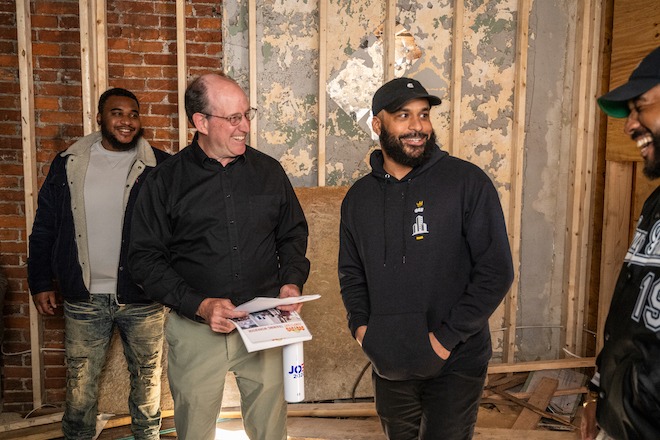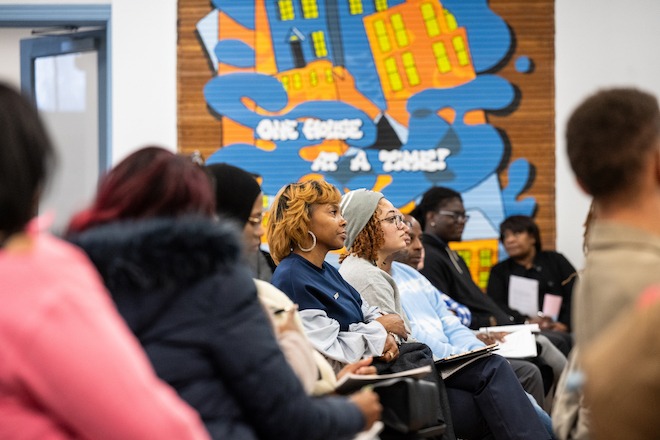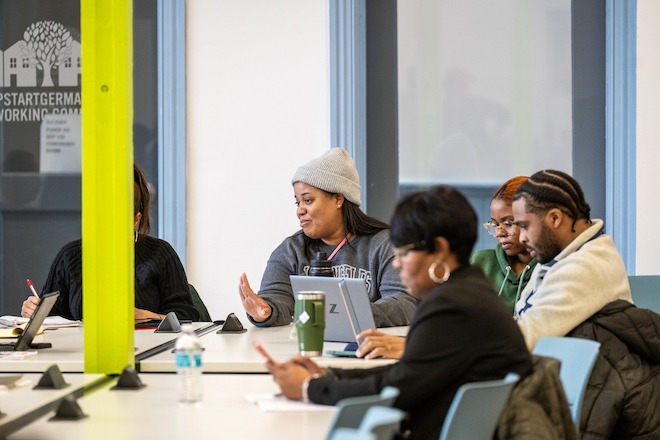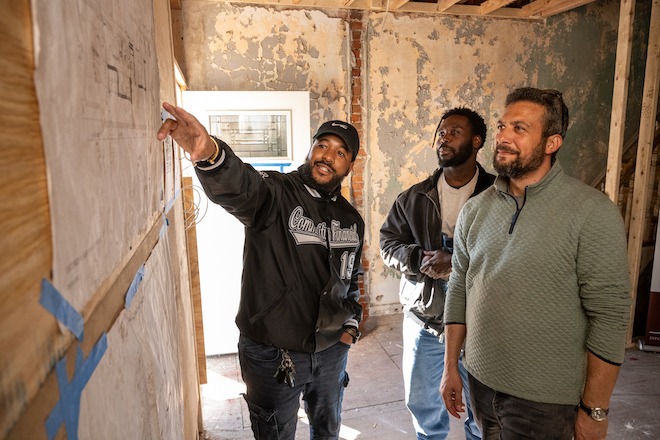Jordan Parisse-Ferrarini has long been entrepreneurial. He learned it from his mother, who was quick to pick up a side hustle — starting a fruit stand, selling makeup door-to-door, selling kitchen products at markets — to help support her family when he was growing up in Mt. Airy and Germantown.
So, it felt natural when, together with his mother and siblings, he founded a company focused on home repairs. They called it Handyman Wizards at first, then Ferrarini Kitchens, Baths and Interiors. A skilled carpenter, he got his electrician’s license, his realtor’s license, and then earned a construction management certificate.
He was a successful contractor, but breaking into real estate development was a struggle. It was the early 2010s, and he felt frustrated by going to trade shows and finding that the industry still seemed so white. “There were 50,000 to 100,000 successful people and really no people of color,” he recalls.
Then, in 2015, he saw a Facebook post about a training program that aimed to help people break into the business. He signed up — and has since used what he learned to build his own company and develop more than 100 housing units.
Parisse-Ferrarini is one of more than 3,000 graduates of Jumpstart, a Germantown-based program that is fundamentally altering who benefits from neighborhood redevelopment in Philadelphia. In an industry where 99 percent of real estate firms are White-owned and, as a 2021 Knight Foundation study found, only 2.8 percent are owned by women, Jumpstart tells a very different story: 83 percent of the people who use its loan program are Black, five percent are Hispanic and 51 percent are women.
“Jumpstart is not just mentoring in real estate, but promoting underrepresented minorities in real estate and focusing on traditionally overlooked, marginal, or distressed neighborhoods.” — Kevin Gillen, Drexel’s Lindy Institute for Urban Innovation
With this program now at its 10-year mark and expanding throughout the city and beyond, The Philadelphia Citizen and The Chestnut Hill Local teamed up to investigate its impact. Our analysis of 460 Jumpstart loans and an anonymous survey of 95 borrowers reveals not just startling demographic results. It also shows that these new developers — 95 percent of whom are Philadelphia area residents — are largely investing in their own communities. Twenty percent work in their own zip codes and 72 percent of all developers live within Philadelphia proper.
Jumpstart, which has now loaned almost $60 million in neighborhoods across the city, is not just rehabbing properties. It’s building wealth for neighborhood residents and helping communities reap the financial benefits of redevelopment.
Perhaps no one is more surprised at its success than founder Ken Weinstein, a developer who began investing in Mt. Airy and Germantown more than 30 years ago.
“The program has just taken off beyond my expectations,” Weinstein says. “We just had no idea of the demand for the training and mentoring and financing that we were offering.”

Why Jumpstart
Jumpstart is not Weinstein’s first investment in Northwest Philly. A child of the suburbs (he grew up in central Jersey), he remembers being surprised — and frustrated — by the extent of the blight he found in Germantown and the city as a whole.
“I remember first moving to Philadelphia in the mid-80s and being really surprised that there were just vacant, deteriorated houses,” he says. “I decided then and there that I would not normalize that, and I would not accept that’s just the way it is, and that I wanted to do something about it.”
His Germantown-based, commercial real estate firm, Philly Office Retail set out to address some of that blight and has since redeveloped more than 300 properties, more than half of which are commercial.
Still, there was far too much deteriorating real estate for one developer to handle. And he was being approached by neighborhood residents who wanted to know how they, too, could learn to develop property. They were interested; they just needed the skills.
Weinstein realized that any time he invested in teaching future developers would pay off — for the neighborhood and his bottom line. Local investors would be more likely to keep their development dollars within the neighborhood, he reasoned, and benefit the community as a whole.
“If local residents are doing the development, then the profit that they’re making stays within the community, which improves the commercial corridor and increases the quality of life within Germantown,” Weinstein says.
So he launched a training program. It started with Bruce McCall and Nancy Larcom O’Brien, who met with him in his office. Two people quickly became 10, then 20. The meetings kept growing in size, so Weinstein had to move them – first to the Mt. Airy CDC, then La Salle University, then Jefferson University. Now, Jumpstart trains 70 people at a time, and Weinstein has created a dedicated training room in his Germantown headquarters.

Does Jumpstart work?
To keep investment in the neighborhood, Weinstein gives priority to people living in Germantown and the surrounding neighborhoods — East Falls, Mt. Airy, West Oak Lane, and Nicetown. If there’s room, he’ll open it up to people who live in other neighborhoods. People who live outside the city can sign up after that.
“I have absolutely no problem with outside investors coming in, as long as they’re doing the right type of development, as long as they’re talking to neighbors and they’re caring about the communities in which they develop and invest,” Weinstein says. “But I wouldn’t want it to be an overwhelming percentage.”
We looked at the program’s loan data and compared buyers zip codes to the zip codes of the properties they purchased and we looked at data from an anonymous survey of 95 borrowers. Not all Jumpstart graduates use Jumpstart loans, however, and the program does not keep track of where they purchase and develop properties.
Only 5 percent of the 460 loans Jumpstart has given are to developers outside of the Philadelphia Metropolitan Statistical Area — that is Philly and its surrounding counties.
They are going primarily to people who are underrepresented in the real estate and development industries.
And a good portion of Jumpstart’s loans — 20 percent — go to developers who live within the same zip code as the property they’re purchasing. Zip code isn’t a perfect measure for whether someone considers a community home, however. Some people may only live a zip code or two over from the properties they’re developing. Others might have family ties to the neighborhood, even if they’ve moved to another part of the city.
For Tyra Childs, a Jumpstart Tioga participant, the program helped her buy and rehab a property in the neighborhood where she grew up, West Oak Lane. She graduated from the program in 2020 and has since rehabbed two properties — one in West Oak Lane and one in West Philly. She sold one of the properties and is renting out the other. Before Jumpstart she was working in sales, but an interest in real estate drove her to get her realtor’s license in 2018.
“I learned a lot from meeting with Jumpstart and joining the program,” she says. “They gave me insight on how to scout for homes, and the full renovation process.”
Jumpstart’s approach
Jumpstart invests in parts of the city that, like Germantown, are “middle” neighborhoods — they’re not in complete disrepair, but neither are they experiencing the development frenzy that rapidly changing neighborhoods like Fishtown have experienced, so buyers and renters aren’t priced out by a crush of competitive demand. About 41 percent of Philadelphians live in these kinds of neighborhoods, per a 2017 report by the Reinvestment Fund, a city-based nonprofit with a mission of equitable economic growth.
“If we renovated houses in Fishtown and Center City and Manayunk, the rental and sales price of the houses would be much higher,” said Weinstein. “We are producing housing that is more affordable than the general market.”
The program includes intensive instruction as well as financing and mentorship.
The education piece is a 10-session, 13.5-hour series of classes that teach inexperienced developers about property sourcing, deal financing, construction and the process of leasing or selling a property. It now trains about 70 people at a time in Germantown and offers programs in Kensington, Tioga, North Philly, West Philly and Southwest in addition to Germantown.
The cost for in-person training is $125. Jumpstart donates $80 of that $125 to local nonprofits, and also offers a virtual option for $75. After they graduate, Jumpstarters can continue their education through “Jumpinars,” which are mini sessions that dive deeper into a particular development topic, such as securing a rental license from the City or refinancing a rehab project.
Graduates gain access to Jumpstart’s financing program, which has distributed 460 loans totaling $57,891,367 since 2015. Using Philly Office Retail’s lines of credit, Jumpstart offers loans at about nine percent interest — notably lower than the standard short-term loans used by developers, which range from 9.5 to 11.25 percent. The program will finance up to 85 percent of a project’s total costs, including acquisition, with a maximum loan of $350,000 for single-unit properties. Because no principal is paid until the property is sold or refinanced, and no interest is due until the renovation is complete, the total cost of borrowing is just the $1,500 commitment fee, which covers the cost of four inspections.
To secure financing, graduates must submit an online application with a business plan projecting costs and potential profits, along with information about comparable properties and a construction budget.
The loan program has a success all its own, with its notably low default rate — just one default out of 460 loans. That’s a .2 percent rate, far less than the around 1 percent that is typical for traditional construction loans. “I think any bank would love to have that success,” Weinstein says.
The final component of the program — mentorship — connects new developers with experienced Jumpstart grads, helping newbies avoid common mistakes and better manage their projects.
And that mentorship, according to Jumpstart graduate Parisse-Ferrarini, turns out to be invaluable. “In real estate, you win when you buy. So you need to be able to project forward what your cost of construction is going to be, and what the value of the property is going to be on the back end,” he says. “One of the biggest challenges is having enough education to make an informed decision. As a newer developer, that can make or break you.”

Jumpstart and gentrification
The impact of Jumpstart can be seen all over Germantown, on blocks where once blighted buildings have been turned into shiny new homes.
Some local activists are concerned that gentrification — and displacement of long-term residents — will follow. Redevelopment can reduce blight, they say, but it can also lead to increases in rents and housing prices, making the neighborhood unaffordable for low income earners.
“There’s a fine line between trying to bring things back into use and making them safe, and then revitalization and gentrification,” says Lindsay Stolkey, a housing organizer with Germantown Residents for Economic Alternatives Together (GREAT).
Activists also worry that developer-focused programs could inadvertently displace residents who can’t maintain their properties. “What we’ve seen when we do outreach in the community is that people come up to our table and the first things they’re asking for are resources to help maintain their property,” says Yonique Myrie, an organizer with GREAT. “Those people end up selling their properties for little money.”
These activists have reason for concern. The need for affordable housing in both Germantown and the city writ large is high. The Philadelphia Housing Authority (PHA) has not opened its waitlist for its subsidized housing since 2013; there are 40,000 people on the list. About 40 percent of Philadelphia households are cost-burdened, spending over 30 percent of income on housing. And Germantown incomes, on average, lag behind those of the city. Census Bureau data show that the median household income is $45,727 — more than 24 percent lower than the citywide average of $60,698.
Jumpstart, operating without public subsidies as a market-based program, wasn’t designed as an affordable housing program. But it does include some affordability measures. Borrowers must rent their properties at rates that fall at or below 70 percent of the area median income (AMI). So, $1,400 for a studio, $1,500 for a one bedroom, $1,800 for a two bedroom, and so on. If a borrower decides to sell a property, they must do so for 90 percent of the AMI. That means $391,400 for a five bedroom house. On average, Jumpstart homes sell for somewhat less than the Germantown average of $224,000, and significantly less than the citywide average of $260,000.
“One of the biggest challenges is having enough education to make an informed decision. As a newer developer, that can make or break you.” — Jordan Parisse-Ferrarini
Still, activists say, the math doesn’t work for many Germantown families, whose incomes don’t match the regional average.
They say pegging income requirements to regional averages — a standard practice by banks, government agencies, and housing programs — is a problem all its own. For Philadelphia, that income statistic includes wealthier surrounding counties and parts of Delaware, New Jersey, and Maryland.
“AMI is based on just such a large geographic scale that isn’t relevant to the people who actually live in the neighborhood,” Stolkey says. She adds that GREAT has asked Jumpstart to use a different metric. Jumpstart uses AMI because it is a requirement of their lenders.
Jumpstart, affordable housing and building wealth
Some Jumpstart graduates do go on to focus on developing affordable housing. Jumpstart doesn’t track graduates outside of its loan program. So, though they use AMI and operate without subsidies, graduates may go on to rent and sell for below these levels or develop affordable housing with the help of subsidies as they grow in their development careers.
Four years ago, Jumpstart partnered with the PHA on a Property Sourcing Lottery program that allows graduates to purchase one of 45 blighted PHA properties for $10, so long as they promised to sell them to people making less than 80 percent of the area median income. For a family of four, that meant earning about $62,000 (when PHA first announced the program in 2021). The program has had three different rounds over the years; the final round of winners is in the final stages of rehabbing their homes.
“Several of those PHA lottery winners were, in fact, former PHA residents who wanted to give back,” Weinstein says.
Jumpstart grad Antonio Cerqueira, who lives in South Philadelphia, did his first PHA project in Point Breeze, where he sold a house to a low-income family who had been struggling to pay $1,800 per month in rent. With their new mortgage, they were able to save $700 per month and get the guarantee that their housing costs would remain consistent from year to year. And Cerqueira still made a profit from the sale.
“I fell totally in love with this model of affordable housing,” he says.
Parisse-Ferrarini likes the model too, and is breaking ground on 10 such projects soon through PHA’s Turn the Key program.
One of his recent buyers, Cheron Sudler, was able to purchase a home that her family had sold when her step-grandmother died for $170,000. She had been searching for a house for five years when a coworker referred her to Parisse-Ferrarini’s company.
“Everyone was excited because they lost the house when our grandmother passed away,” Sudler says. “The fact that I now own it is crazy.”

Continuing to grow Jumpstart
While Jumpstart homes may be out of reach for very low income earners, it is building wealth for people who participate.
The average Jumpstart loan is $125,578 and covers up to 85 percent of a project’s total acquisition and construction costs. With total costs averaging around $147,000, developers who sell homes at the typical $202,000 price point make approximately $55,000 in profit.
Some graduates have built substantial portfolios. Palak Shah, a former mechanical engineer, parlayed her Jumpstart training into a 23-rental property portfolio worth $3 million by 2019.
But the program’s most profound impact may be in the network of entrepreneurs it has created — developers who are now helping others transform their own communities.
Parisse-Ferrarini has helped longtime Germantown residents buy or remain in their own homes. His nonprofit training program, Trades for A Difference — which offers job skills, apprenticeship and an entrepreneurial education program — has offered free repair services to seniors.
Cerquiera helped Jumpstart develop its Spanish-speaking training program. Shah has created a training program that helps women and LGBTQ people become developers because she understands the unique challenges women face. Hundreds of people have participated.
“Women feel super uncomfortable asking a lender a question because they think that they should already know the answer,” Shah says. “When you see other women succeed, it feels more real.”
As Jumpstart’s success in building both housing and wealth has grown, it has caught the attention of urban development experts.
There are few programs like it, save for those that have directly adopted the Jumpstart model, according to Dr. Kevin C. Gillen, senior research fellow at Drexel’s Lindy Institute for Urban Innovation. So-called real estate coaching programs that promise to teach similar skills cost between $500 and $10,000 per month and don’t teach the same depth of information as Jumpstart.
“Jumpstart has a social mission in addition to an economic mission,” Gillen says. “They’re not just mentoring in real estate, but promoting underrepresented minorities in real estate and focusing on traditionally overlooked, marginal, or distressed neighborhoods.”
That mission is now expanding well beyond Germantown, with the program now operating in 15 other communities in, around and outside of the city, with 11 more in the works. While Weinstein administers loans for most programs throughout Philadelphia, Jumpstart Kensington partnered with socially conscious development firm Shift Capital to establish its own financing system; they now work with the nonprofit Impact Services.
The model is proving replicable in other cities too. Prudence Browne launched Jumpstart Norristown in 2020, and the Wilmington program has become the most active location, second only to Germantown. Over the next several years, Jumpstart plans to expand to Washington, D.C.; Gary, Indiana; Dover, Delaware; and York, Pittsburgh and Chester, Pennsylvania. Jumpstart is even bringing the program to their first rural community in Meadville, outside Butler, PA.
“We would love to see 50 Jumpstart programs around the country in the next several years. And I think that’s doable because we have now proven that our model is effective and can improve a neighborhood,” Weinstein says.

The Philadelphia Citizen is one of more than 25 news organizations powering the Philadelphia Journalism Collaborative. This article is part of a series on things that affect daily life in our city where the problem and symptoms are obvious, but what’s driving them isn’t. Follow at @PHLJournoCollab
Additional reporting by Carla Robinson at Chestnut Hill Local, where this piece also ran.
Corrections: A previous version of this story misstated the percentage of loans that went to developers with Philadelphia and the MSA and the number of Jumpstart programs. Ninety-five percent of developers live within the Philadelphia MSA and 72 percent live in Philadelphia proper. There are 15 other, active Jumpstart programs.
Clarifications: A previous version of this post stated Jumpstart Kensington partnered with Shift Capital; Jumpstart now works with the nonprofit Impact Services. When PHA first announced the sale of 45 blighted properties for $10 in 2021, the AMI for a family of four was about $62,000.
![]() MORE DEVELOPMENT…FOR GOOD
MORE DEVELOPMENT…FOR GOOD



